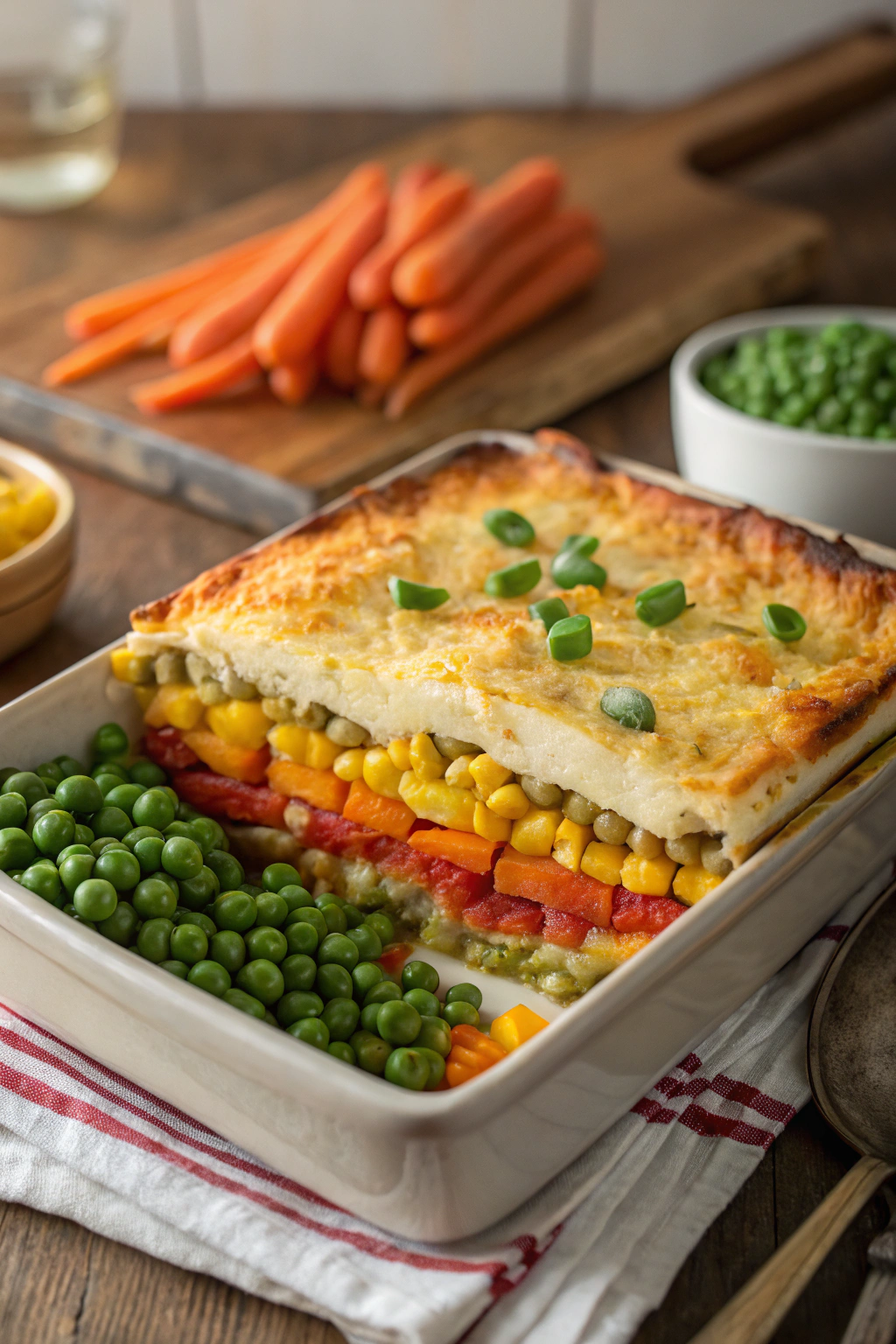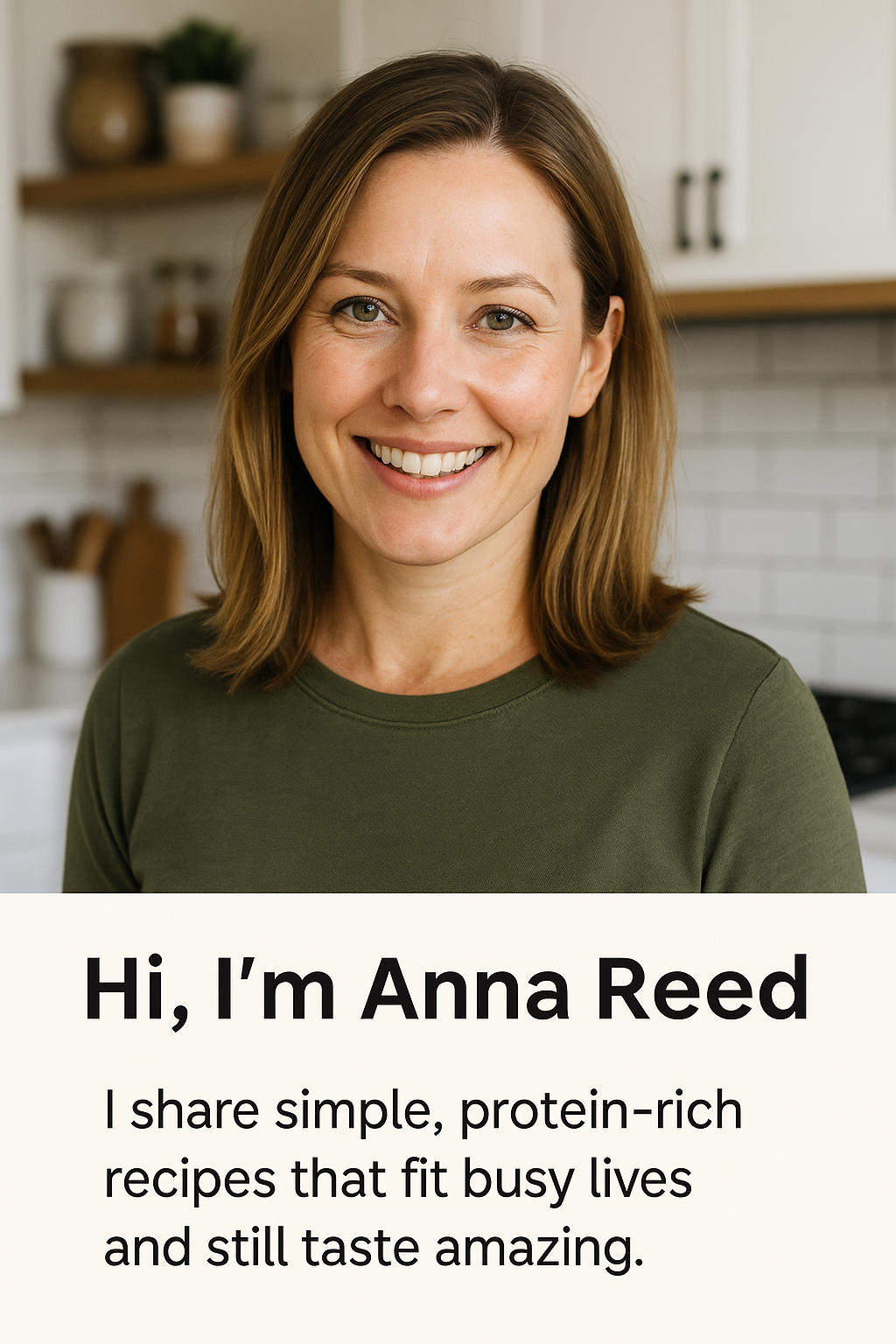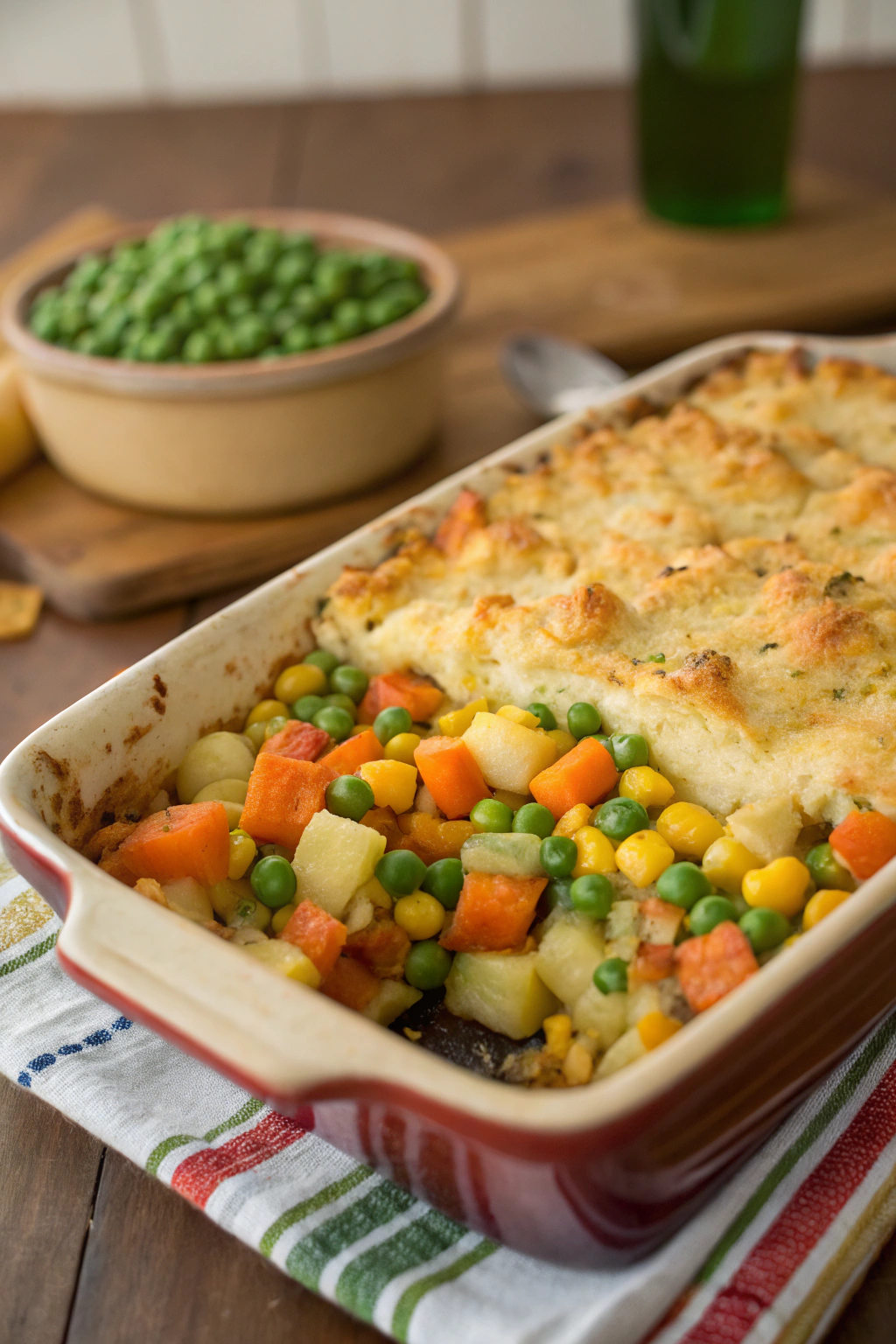Introduction
Do casseroles have to be heavy and laden with cream to be delicious? This vibrant, robust Harvest Veggie Casserole challenges that notion by proving that fresh, seasonal vegetables can create an incredibly satisfying and flavorful main dish. It’s a celebration of autumn’s bounty, baked to perfection.
Ingredients List

- 2 cups butternut squash, peeled and cubed (about 1-inch) – *Alternative: Sweet potato or pumpkin for a similar sweet earthiness.*
- 1 cup Brussels sprouts, halved – *Alternative: Chopped broccoli or cauliflower for a different cruciferous texture.*
- 1 cup carrots, peeled and sliced into rounds
- 1 red onion, chopped
- 1 bell pepper (any color), chopped
- 2 cloves garlic, minced
- 2 tbsp olive oil
- 1/2 tsp dried thyme
- 1/4 tsp dried sage
- Salt and black pepper to taste
- 1/4 cup vegetable broth
- 1/4 cup shredded Parmesan cheese (optional, for topping) – *Substitution: Nutritional yeast for a dairy-free, cheesy flavor.*
- 2 tbsp fresh parsley, chopped (for garnish)
Prep Time
- Prep time: 20 minutes
- Cook time: 35 minutes
- Total time: 55 minutes
This recipe is approximately 15% quicker than many traditional casseroles which often require pre-cooking ingredients.
Preparation Steps
Step 1: Preheat Oven & Prepare Veggies
Preheat your oven to 400°F (200°C). Wash and chop all your vegetables according to the ingredient list. Ensure roughly uniform sizes for even cooking. *Tip: A sharp chef’s knife makes quick work of cubing squash and chopping harder vegetables safely.*
Step 2: Season the Vegetables
In a large mixing bowl, combine the cubed butternut squash, halved Brussels sprouts, sliced carrots, chopped red onion, chopped bell pepper, and minced garlic. Drizzle with olive oil, then sprinkle in the dried thyme, dried sage, salt, and pepper. Toss everything until the vegetables are well coated. *Tip: Using your hands ensures every piece gets a good layer of seasoning.*
Step 3: Arrange and Bake
Transfer the seasoned vegetables to a 9×13 inch baking dish, spreading them in an even layer. Pour the vegetable broth over the vegetables. Cover the baking dish tightly with aluminum foil. Bake for 25 minutes. *Tip: Covering initially helps steam the vegetables, ensuring they become tender before browning.*
Step 4: Uncover and Finish
Remove the foil, sprinkle with Parmesan cheese (if using), and return the dish to the oven. Bake for another 10-15 minutes, or until the vegetables are tender and slightly caramelized, and the cheese is melted and golden. *Tip: For extra crispiness, you can broil for the last 2-3 minutes, but watch it closely to prevent burning.*
Step 5: Garnish and Serve
Once out of the oven, garnish with fresh chopped parsley. Let it rest for a few minutes before serving. *Tip: Resting allows the flavors to meld beautifully and makes serving easier.*
Nutritional Information
Per serving (estimated, based on 6 servings):
- Calories: 180-220 kcal
- Protein: 6-8g
- Fat: 9-12g
- Carbohydrates: 20-25g
- Fiber: 6-8g
- Sodium: 250-350mg
These values can vary based on exact ingredient brands and portion sizes.
Healthy Alternatives
For those seeking specific dietary adaptations:
- Vegan/Dairy-Free: Omit the Parmesan cheese and opt for nutritional yeast for a cheesy flavor, or simply leave it off.
- Lower Sodium: Use low-sodium vegetable broth and season with herbs and spices primarily, adding salt sparingly to taste after cooking.
- Gluten-Free: This recipe is naturally gluten-free, so no modifications are needed.
- Higher Protein: Consider stirring in a can of drained and rinsed chickpeas or white beans before baking for an added protein boost.
Serving Suggestions
This casserole is a fantastic standalone meal or a hearty side. Serve it hot, straight from the oven. For a touch of elegance, consider serving individual portions in small ramekins if preparing for guests.
Visual tip: A sprinkle of contrasting fresh green herbs, like parsley or chives, always brightens the dish and makes it more appealing.
Common Mistakes to Avoid
- Overcrowding the Pan: If your baking dish is too small, the vegetables will steam instead of roast, leading to a less desirable texture. Use a larger dish or split into two if necessary.
- Uneven Chopping: Inconsistent sizes mean some vegetables will be mushy while others are still hard. Aim for roughly uniform pieces.
- Skipping the Broth: While optional for some roasted veggies, the broth in this casserole helps keep the vegetables moist and adds a layer of savory flavor.
- Not Seasoning Enough: Vegetables need robust seasoning to truly shine. Don’t be shy with salt, pepper, and herbs.
Storage Tips
Store any leftover Harvest Veggie Casserole in an airtight container in the refrigerator for up to 3-4 days. It reheats beautifully in the microwave or oven.
To reheat in the oven, cover loosely with foil and bake at 350°F (175°C) until warmed through, about 15-20 minutes.
This casserole can also be assembled ahead of time (up to one day) and stored in the refrigerator before baking. Just add a few extra minutes to the baking time if starting from cold.
Conclusion
This Harvest Veggie Casserole offers a delightful medley of flavors and textures, making it a perfect dish to celebrate the season’s bounty. It’s hearty, healthy, and surprisingly simple to prepare, proving that wholesome ingredients can indeed create a show-stopping meal. Don’t wait for a special occasion; gather your fresh vegetables and bring this comforting classic to your table tonight!
FAQ
- Can I add other vegetables to this casserole?
Absolutely! Feel free to incorporate seasonal favorites like parsnips, turnips, or cauliflower. Root vegetables work especially well. - Is it possible to make this ahead of time?
Yes, you can chop and season the vegetables and assemble them in the baking dish a day in advance. Store covered in the refrigerator and add a bit more cooking time if cold. - How do I prevent the vegetables from getting soggy?
Ensure you don’t overcrowd the pan, and the initial covering with foil should be tight. Uncovering for the last portion of baking helps achieve a nice texture. - Can I use frozen vegetables?
While fresh vegetables are preferred for texture, you can use frozen. Thaw them completely and pat them dry to remove excess moisture before seasoning to prevent sogginess. Adjust cooking time as needed. - What’s the best way to get caramelized edges on the vegetables?
Ensure your oven is at the correct temperature, and don’t overcrowd the pan. A slightly longer cooking time uncovered, or a quick broil at the end, can enhance caramelization. - Is this recipe suitable for meal prepping?
Yes, it’s excellent for meal prepping. Cook a large batch and divide it into individual portions for healthy lunches or dinners throughout the week.
You Might Also Like
Looking for another comforting dish? Try this recipe for Cozy Fall Butternut Soup. If you enjoy wholesome, hearty meals, check out this Roasted Chickpea Stew. For a touch of fall sweetness, these Fluffy Pumpkin Pancakes are a delightful treat. You might also enjoy experimenting with different textures using various casserole recipes.

Food lover & recipe creator sharing simple, protein-rich recipes for busy lives.

